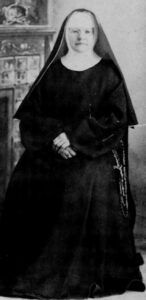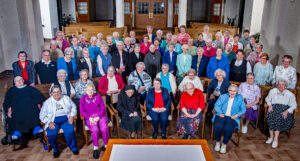The power of a vision, the strength of an idea, the courage of imagination
March 14, 2023“Before and above all things, care must be taken of the sick, that they be served in very truth as Christ is served.” – Rule of St. Benedict, Chapter 36
Throughout their 131-year history in the Duluth Diocese, Benedictine’s founders, the Sisters of St. Scholastica Monastery in Duluth, have taken on challenges unheard of for women of their time, establishing schools, hospitals and one of the first health insurance programs. Despite poverty and a harsh, unforgiving climate, they adapted to new circumstances to survive, grow and serve. During Women’s History Month and National Catholic Sisters Week, we take a moment to recognize their legacy of healing ministry and service that Benedictine is honored to carry forward.
From European cloister to American frontier
In 1852, three Benedictine Sisters left St. Walburg Abbey in Eichstatt, Bavaria, for northwestern Pennsylvania at the request of Abbot Boniface Wimmer of St. Vincent’s Archabbey, also in Pennsylvania. They were to serve the needs of German-Catholic immigrants in what was known as the “rural frontier.” There, they opened a school for immigrant girls. Five years later, four Sisters, two candidates and one orphan girl moved west to the Minnesota frontier and established St. Benedict’s Convent in St. Joseph, Minn., which became the founding Motherhouse of St. Scholastica Monastery, Duluth.
The call to serve Duluth

When Mother Scholastica Kerst, then Prioress of St. Benedict’s Convent, visited the snowy, semi-wilderness community of Duluth, Minnesota in December of 1880, she was continuing the adventure begun by her European foremothers. It was an exploratory trip in response to a request from the vicar apostolic of Northern Minnesota to start a school and a hospital in Duluth. Mother Scholastica Kerst agreed and the following year three sisters arrived in Duluth to open the first of several schools. In 1888, they also established St. Mary’s Hospital.
The Diocese of Duluth was established in 1889 by Pope Leo XIII. The Reverend James T. McGolrick was appointed the first bishop. He wanted to include a permanent community of Benedictine Sisters in his Diocese, so he invited members of St. Benedict’s Convent to Duluth. Thirty-two Sisters answered the call and established St. Scholastica Monastery in 1892, led by Mother Scholastica Kerst.
During Mother Scholastica Kerst’s 19 years as prioress, the monastery grew from 32 to 161 members. By the time of her death in 1911, the monastery was staffing 18 elementary schools, four secondary schools, five hospitals, an orphanage, a retirement home and a school of nursing that would eventually become the College of St. Scholastica. At her funeral, Bishop McGolrick noted Mother Scholastica Kerst’s significant influence on Duluth, saying, “She built my diocese.”
Healthcare innovation and “Sister Lumberjack”
The Benedictine Sisters developed several hospitals across northern Minnesota, including St. Mary’s Hospital in Duluth, St. Anthony’s Hospital in Bemidji, St. Joseph’s Hospital in Brainerd, St. Vincent Hospital in Crookston, St. Benedict’s Hospital in Grand Rapids and Hibbing General Hospital.

During the early years, the hospitals were funded by two main sources of income: fees from patients and from what came to be known as lumberjack tickets. These innovative tickets offered affordable health care to men working in lumber (and then mining) camps at any Benedictine hospital for a single yearly fee. Sister Amata Mackett served as the chief saleswoman of the program. She visited lumberjack and mining camps across northeastern Minnesota to sell annual the tickets, dispense advice, darn socks and bake pies in the camp’s cookhouses. At six feet tall and weighing more than 200 pounds, she was not intimidated by the men and eventually earned the name, “Sister Lumberjack.”
Benedictine today
By 1965, St. Scholastica Monastery was home to 520 members. Additional parish schools were staffed in Duluth and northeastern Minnesota as well as in Minneapolis, Phoenix and Cincinnati. Their service reached as far as Antofagasta, Chile, where several Sisters opened a healthcare clinic and worked in the local parish and school. The Sisters left Chile in 1979 when the mission became self-sustaining.
In 1980, the Benedictine Health Center (BHC) opened in Duluth, offering nursing care to 120 elders as well as a children’s daycare center. Including childcare at a skilled nursing facility was unique at that time and brought the sounds of play and laughter to the older adult residents.

As the years passed, changes in the health care marketplace and the Monastery prompted a change in the Sisters’ healthcare ministry. In 1985, the Benedictine Health System was created to further the Sisters’ ministry, uphold their mission, and steward their resources. Today, this is the faith-based, mission-driven nonprofit known as Benedictine, a network of 30+ senior living communities in five states, is one of the largest independent Catholic senior care organizations in the United States.
Benedictine is honored to be part of an enduring legacy of service, flourishing then and now under the sponsorship and prayers of the Sisters of St. Scholastica Monastery: “Thank You for the power of a vision, the strength of an idea, and the courage of imagination.”
